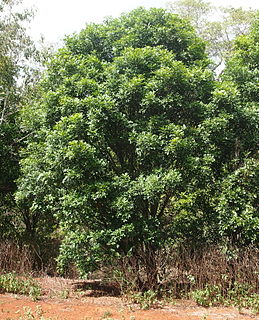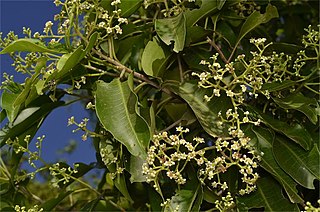
Austrobaileya is the sole genus consisting of a single species that constitutes the entire flowering plant family Austrobaileyaceae. The species Austrobaileya scandens grows naturally only in the Wet Tropics rainforests of northeastern Queensland, Australia.

Austromuellera is a genus of only two known species of medium-sized trees, constituting part of the plant family Proteaceae.

Hakea salicifolia commonly known as the willow-leaved hakea, is species of flowering plant that is endemic to eastern Australia. It is an adaptable, fast growing small tree or shrub with attractive foliage and cream white flowers.

Atalaya is a genus of eighteen species of trees and shrubs of the plant family Sapindaceae. As of 2013 fourteen species grow naturally in Australia and in neighbouring New Guinea only one endemic species is known to science. Three species are known growing naturally in southern Africa, including two species endemic to South Africa and one species in South Africa, Swaziland and Mozambique.

Geijera salicifolia, commonly known as glasswood, green satinheart or scrub wilga, is a species of shrub or tree in the family Rutaceae and is native to Australia, New Guinea and New Caledonia. It has narrow elliptic to egg-shaped leaves, small white flowers in loose groups and oval to more or less spherical fruit, each containing a shiny black seed.
Helicia australasica, also named Austral oak or creek silky oak, is a species of rainforest trees from the flowering plant family Proteaceae.

Wendlandia is a genus of flowering plants in the family Rubiaceae. It is found in northeastern tropical Africa, and from tropical and subtropical Asia to Queensland.
Beilschmiedia bancroftii is a tree species in the family Lauraceae. It is native to Queensland in Australia. Common names include yellow walnut, yellow nut and canary ash.
Bernard Hyland, known as Bernie Hyland, has a long career as an Australian botanist.

Atalaya multiflora, known as the broad leaved whitewood, is a rare and endangered rainforest tree of the soapberry family native to eastern Australia.

Atalaya calcicola is a species of trees native to Northern and Eastern Queensland.

Carnarvonia is a flowering plant genus of a single species, commonly named red oak or red silky oak and constituting part of the plant family Proteaceae. The single species named Carnarvonia araliifolia grows to large trees of 30 m (100 ft) or more. They grow naturally only (endemic) to the Wet Tropics rainforests region of north-eastern Queensland, Australia. The species has two described varieties, C. araliifolia var. araliifolia and C. araliifolia var. montana, and the common names are used for both.

Lasjia is a genus of five species of trees of the family Proteaceae. Three species grow naturally in northeastern Queensland, Australia and two species in Sulawesi, Indonesia. Descriptively they are the tropical or northern macadamia trees group. Lasjia species characteristically branched compound inflorescences differentiate them from the Macadamia species, of Australia, which have characteristically unbranched compound inflorescences and only grow naturally about 1,000 km (620 mi) further to the south, in southern and central eastern Queensland and in northeastern New South Wales.
Helicia lewisensis is a species of rainforest trees, of northeastern Queensland, Australia, from the flowering plant family Proteaceae. It is endemic to the northern upland rainforests of the Wet Tropics region, from about 900 to 1,330 m altitude.
Helicia lamingtoniana, also named Lamington's silky oak, is a species of rainforest trees, of northeastern Queensland, Australia, from the flowering plant family Proteaceae.
Helicia blakei, also named Blake's silky oak, is a species of rainforest tree, of northeastern Queensland, Australia, from the flowering plant family Proteaceae.
Helicia nortoniana, also named Norton's silky oak, is a species of rainforest trees, of northeastern Queensland, Australia, from the flowering plant family Proteaceae.
Hollandaea sayeriana, sometimes named Sayer's silky oak, is a small species of Australian rainforest trees in the plant family Proteaceae.
Hollandaea riparia, sometimes named roaring Meg hollandaea, is a species of Australian rainforest tree, in the plant family Proteaceae.
Hollandaea porphyrocarpa is a species of small Australian rainforest tree in the plant family Proteaceae. It is endemic to restricted areas of the rainforests of the Wet Tropics region of northeastern Queensland.











